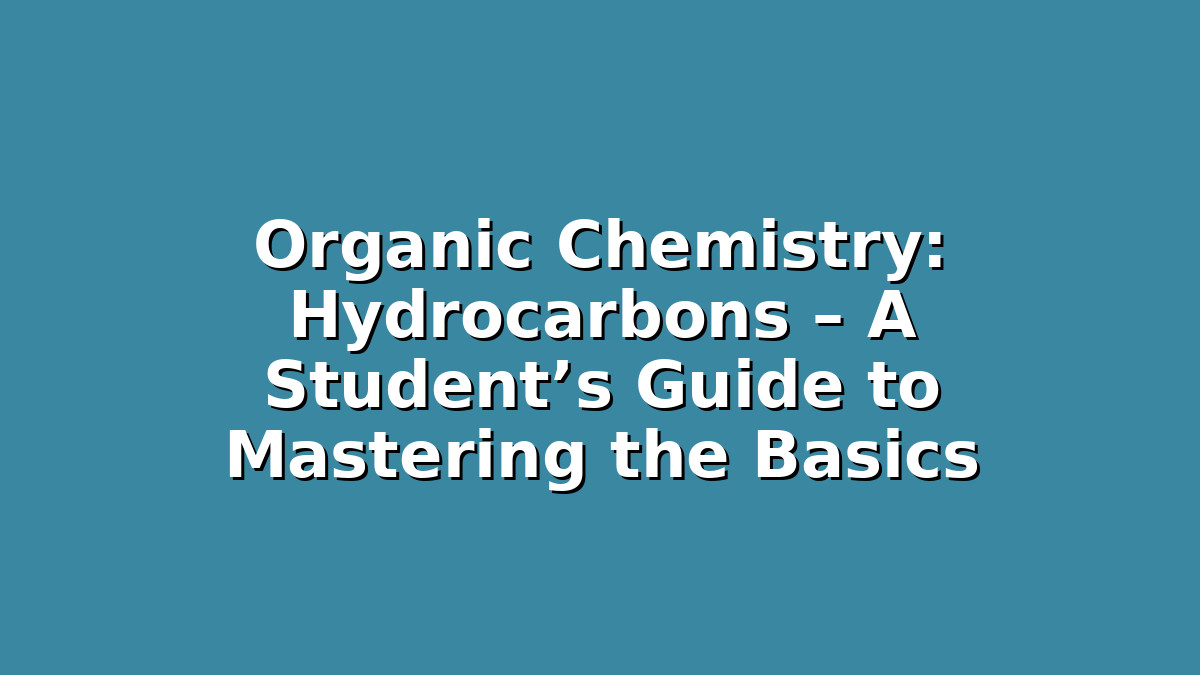Organic chemistry can seem daunting at first, especially when you encounter topics like hydrocarbons that form the foundation of many complex reactions. If you’re a student preparing for exams or simply aiming to strengthen your understanding, this guide is tailored to help you grasp hydrocarbons effectively while offering practical study tips. By the end of this article, you’ll feel more confident navigating this crucial topic and ready to tackle exam questions with ease.
Introduction to Hydrocarbons
Hydrocarbons are organic compounds composed entirely of carbon (C) and hydrogen (H) atoms. They are the simplest type of organic molecules and serve as the starting point for studying more complex organic chemistry concepts. Hydrocarbons are broadly categorized into two main types: saturated hydrocarbons (alkanes) and unsaturated hydrocarbons (alkenes and alkynes). Additionally, there are aromatic hydrocarbons, such as benzene, which have unique ring structures.
Understanding hydrocarbons is essential because they are the building blocks of fuels, plastics, and many other materials. For students, mastering the nomenclature, properties, and reactions of hydrocarbons is crucial for a strong foundation in organic chemistry.
—
Section 1: Understanding Types and Structures of Hydrocarbons
Knowing the different types of hydrocarbons and their structures is the first step toward mastering this topic. Here’s a breakdown:
– Alkanes (Saturated Hydrocarbons): These contain only single bonds between carbon atoms. They are called saturated because each carbon atom forms as many single bonds as possible with hydrogen atoms. Examples include methane (CH4), ethane (C2H6), and propane (C3H8).
– Alkenes (Unsaturated with Double Bonds): These compounds have at least one carbon-carbon double bond (C=C). They are more reactive than alkanes. For example, ethene (C2H4) and propene (C3H6).
– Alkynes (Unsaturated with Triple Bonds): These have at least one carbon-carbon triple bond (C≡C). They are even more reactive than alkenes. Examples include ethyne (acetylene, C2H2).
– Aromatic Hydrocarbons: These contain benzene rings or similar structures with delocalized electrons. Benzene (C6H6) is the most common aromatic hydrocarbon.
Study Tip:
Use molecular model kits or drawing software to visualize these structures. Building models or sketching Lewis structures helps you internalize how atoms bond in three dimensions. When you can see and build the molecule, recalling its properties and reactions during exams becomes much easier.
—
Section 2: Mastering Nomenclature and Naming Conventions
One of the biggest challenges for students is learning how to correctly name hydrocarbons. The International Union of Pure and Applied Chemistry (IUPAC) system provides a consistent way to name compounds, which is essential for clear communication.
Here’s a step-by-step approach to naming hydrocarbons:
1. Identify the Longest Carbon Chain: This becomes the base name (e.g., methane, ethane, propane).
2. Number the Chain: Start from the end nearest a double or triple bond or substituent to give the lowest possible numbers.
3. Name and Number Substituents: Identify any branches or functional groups attached to the main chain and assign them numbers based on their position.
4. Combine the Names: Use prefixes like di-, tri-, and tetra- for multiple identical substituents and arrange names alphabetically.
For example, the compound CH3-CH=CH-CH3 is named but-2-ene because the double bond starts at carbon 2 of a four-carbon chain (but-).
Study Tip:
Practice naming by writing out multiple examples and checking your answers with trusted textbooks or online resources. Flashcards can be helpful—write the structure on one side and the name on the other. This repetition will improve your speed and accuracy on exams.
—
Section 3: Applying Reaction Mechanisms and Exam Strategies
Understanding how hydrocarbons react is key to tackling organic chemistry problems. Common reactions involving hydrocarbons include:
– Combustion: Hydrocarbons react with oxygen producing carbon dioxide and water, releasing energy.
– Addition Reactions: Unsaturated hydrocarbons (alkenes and alkynes) react by adding atoms across double or triple bonds.
– Substitution Reactions: Common in alkanes and aromatic hydrocarbons where one atom or group is replaced by another.
– Elimination Reactions: Removal of atoms from a molecule to form double or triple bonds.
Study Tip:
When studying reaction mechanisms, don’t just memorize steps—try to understand the “why” behind each step. Use arrow-pushing techniques to show electron movement. This will help you predict products even for unfamiliar reactions in exams.
Additionally, practice drawing mechanisms and predicting outcomes under different conditions. Group study is effective: explaining mechanisms to peers reinforces your understanding and reveals knowledge gaps.
Exam Strategy:
– Read questions carefully, paying attention to what is being asked: product prediction, mechanism steps, or naming.
– Write balanced chemical equations.
– Show all steps methodically in mechanisms.
– Use neat, clear diagrams and structures.
– Manage your time—don’t spend too long on one question.
—
Conclusion
Hydrocarbons may seem complex at first, but with focused study and strategic practice, they become manageable and even enjoyable. Remember to start by understanding the basic types and structures, then master naming conventions, and finally delve into reaction mechanisms with confidence.
Regular practice, visualization through models and diagrams, and consistent review are your best tools for success. Don’t hesitate to use flashcards, group studies, and online quizzes to reinforce your knowledge. Stay positive, keep practicing, and trust your ability to master organic chemistry — your hard work will pay off in your exams and beyond.
Good luck, and happy studying!
—

Responses